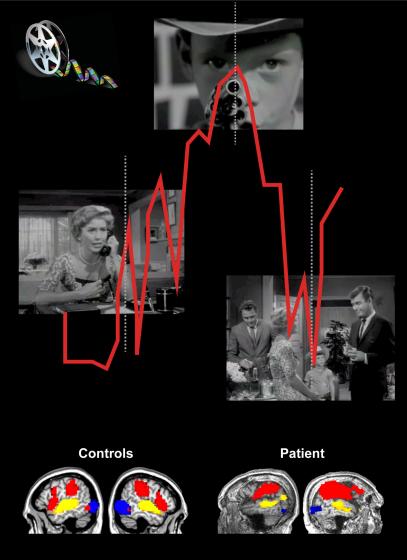

Patients in a vegetative state had brain activity levels matching those of healthy controls while watching a Hitchcock film.
Image credit: Lorina Naci
Results of the study are published in The Proceedings of the National Academy of Sciences (PNAS).
The researchers include postdoctoral fellow Lorina Naci and Canada Excellence Research Chair in Cognitive Neuroscience and Imaging Adrian Owen.
They note that patients who are conscious but unable to speak or show voluntary behavior are unable to convey their conscious experiences to others.
As such, it has been impossible to determine whether these patients are conscious or not, and the team suspects that many patients have been misdiagnosed as lacking consciousness.
To further investigate, the researchers had both healthy and unresponsive participants watch a short film by Alfred Hitchcock while inside the functional Magnetic Resonance Imaging (fMRI) scanner at Western's Centre for Functional and Metabolic Mapping.
The movie was a short film from Hitchcock that had been edited down to 8 minutes in order to keep the scanning session brief.
Though they edited the scenes, the researchers say they maintained the lead storyline, which involved a 5-year-old boy finding his uncle's revolver, partially loading it with bullets, and playing with it at home and in public, unaware of the danger it poses.
'Number of misdiagnosed unconscious patients may be higher'
The researchers say they chose this particular Hitchcock film because of its age and sex neutrality, its wide-ranging appeal and its engaging plot. Additionally, they add that a longer version of the film was previously found to evoke strong brain activity across healthy participants.
After reviewing the brain scans, the team found that the patient who had been unresponsive for 16 years showed a brain response while watching the movie that strongly matched that of the healthy participants.
Naci and colleagues say this result suggests that not only was he consciously aware, but also that he understood the movie.
Commenting further, Naci says:
"For the first time, we show that a patient with unknown levels of consciousness can monitor and analyze information from their environment, in the same way as healthy individuals. We already know that up to 1 in 5 of these patients are misdiagnosed as being unconscious and this new technique may reveal that that number is even higher."
The team says their findings introduce an approach that provides "strong evidence for intact conscious experiences in a brain-injured patient," adding that their study has implications for understanding human consciousness.
"This approach can detect not only whether a patient is conscious," says Owen, "but also what that patient might be thinking. Thus, it has important practical and ethical implications for the patient's standard of care and quality of life."
The researchers explain their findings further in the video below:
The team hopes their new method will help researchers better understand patients who are unresponsive and who may be misdiagnosed as lacking consciousness in the absence of behavior.
In 2013, Medical News Today reported on a study that found patients in a vegetative state are able to recognize loved ones' faces.
No comments:
Post a Comment